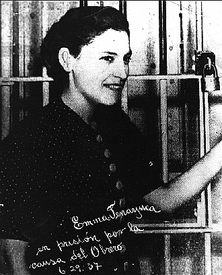
Reprinted from the People’s Weekly World Newspaper
SAN ANTONIO Emma Tenayuca was a resident and radical militant of San Antonios working class west side. Her political formation was shaped, if not heavily influenced, by her early exposure to frequent political rallies and fiery speeches which took place at the Plaza del Zacate with the backdrop of the Great Depression and the early years of nearby Mexicos revolutionary government.
At age 16 she began to organize workers for the national Workers Alliance and the International Ladies Garment Workers Union. By 1934 she was 18-years-old, and was arrested for her leadership role in the organization of Mexican women in the Finck Cigar Strike.
Emma Tenayuca Four years later, in 1937, she joined the Communist Party USA and soon became its chairperson in San Antonio. It was likely the time when she was given the nickname La Pasionaria (literally: the passion flower) after the equally passionate contemporary Basque Communist leader Dolores Ibrruri Gmez.
On January 31, 1938, through her participation with the Workers Alliance, she organized and successfully helped lead an estimated 12,000 pecan shellers in a four-month strike which was in response to poor working conditions and the bosses cutting shellers pay from five to three-cents an hour.
Harsh conditions included a lack of toilets and wash bowls, poor lighting and poor ventilation. The poor ventilation, together with the industrys indoor dust, contributed to the citys tuberculosis rate which was disproportionate to the national average.
A 54-hour work week brought in approximately two dollars for pecan shellers who were mostly women and either Mexican or Mexican American. At that time there was a 250-mile radius around San Antonio which was the largest pecan-producing region in the country.
The region yielded 50 percent of the nations pecan harvest and was San Antonios largest industry. With the representation of International Pecan Shellers Union No. 172 and additional organizational work of the Workers Alliance in which Socialist and Communist workers participated Tenayuca and other labor organizers coordinated the picketing of the citys 400 pecan shelling factories. Pickets were frequently interrupted by police intervention and mass arrests. By August 1939, she had been elected chair person of the Communist Party USA in Texas and was among others scheduled to speak at a gathering of her party at San Antonios Municipal Auditorium.
There was a small number in attendance, less than 200, yet a mob of 5,000 reactionaries rioted outside, and she and the others were placed under temporary, protective custody.
This event was followed by a crackdown on Communists in the San Antonio workforce in which the political-economic machine of this city fired and denied employment to Communist workers and sympathizers.
Tenayucas lack of an income would later cause her to move to California where she entered the teaching profession.
Other causes she took on in her youth included the right to strike, a minimum wage and an end to mass deportations.
In 1981, the Institute of Texan Cultures made Tenayuca part of its exhibit of outstanding Texas women. It was one of many honors she received in her lifetime. She died July 23, 1999 in San Antonio, Texas.


 Join Now
Join Now